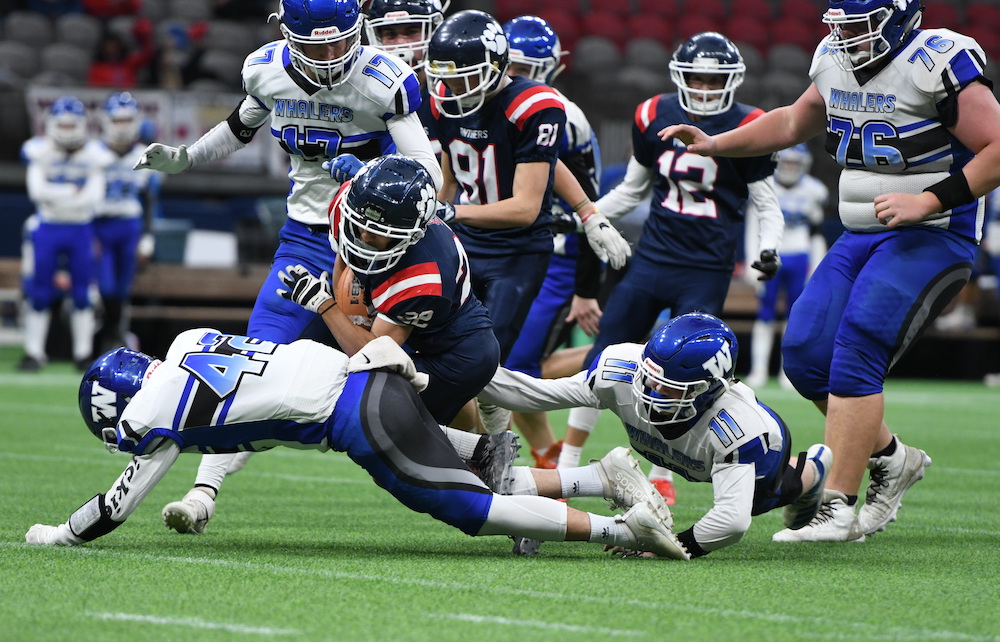Despite a future chalk full of unknowns, the 2020-21 B.C. high school sports season will have its official opening a week from this Thursday.
On Sept. 10, high school football teams are allowed to begin practicing, and although it will all happen under the most restrictive of conditions, hope remains eternal that in the midst of the coronavirus pandemic that some level of meaningful competition will still be available this season for the 70,000 student-athletes who traditionally compete in all manner of sports from September through June.
“We know we’re going to be bound by physical distancing, so our training will look very different from a typical practice,” said B.C. Secondary Schools Football Association president Travis Bell, “but at least we can get kids on the field, working together a bit on their skills and drills.
“To be honest, the fact that we are able to start on the 10th is something we didn’t even know we would be able to do,” continued Bell, also vice-principal at Abbotsford’s Robert Bateman Secondary School, and a former senior varsity football head coach at crosstown W.J. Mouat Secondary. “Our coaches are going to have to be creative with practice plans, but currently, in terms of being able to play games, we’re going to be taking it week to week. It’s up to the dialogue between the Ministry of Education and B.C. School Sports.”
Yet while viaSport announced Aug. 24 that B.C.’s amateur sport sector had progressed to Phase 3 of its Return to Sport plan, one which permits teams placed within cohorts to play games outside of their own associations, such a model does not exist at present for the 70,000 student-athletes in this province. Their participation in extracurricular activities are instead tied to provincial education guidelines, which have currently placed a moratorium on all ‘inter-school’ competition.
B.C. School Sports executive director Jordan Abney admits the immediate future defines a new level of challenge for high school athletic programs in this province.
“Activities can occur but they have to be consistent with guidelines that the ministry has published, which means that activities can happen within their educational cohort,” said Abney. “In most sports, that is very restrictive and makes it challenging to create a training environment.”
As per the guidelines spelled out in B.C.’s Back to School Plan, each so-called “educational cohort” has been set at a maximum of 120 students at the secondary school level, and most immediately affected are traditional fall sports like football, volleyball, soccer, field hockey and cross-country.
Keeping in mind the paramount issue of each student’s safety and health, the task of creating a meaningful practice environment has become exponentially more difficult within the parametres of the current educational cohort regulations.
If, for example, a statistical anomaly existed where every member of a school’s football team happened to be a part of the same educational cohort, then couldn’t that team engage in something approaching a more traditional practice environment?
“Yes,” says Bell, “but we’re not going to make a timetable based on our football team.”
Educational cohort numbers will vary greatly around the province within the 120-student maximum as administrators find what fits best based on their respective school’s scheduling format and student populations.
Yet the bottom line is simple.
“For example, you are coaching a football team, and they are coming from a bunch of different cohorts which are based upon the timetable,” began Bell, who has called a virtual huddle with B.C.’s high school football coaches via Zoom for Wednesday (7 p.m.) as part of the BCSSFA’s Return To Play. “One group might be coming from Block A. The school is thus operating under the assumption that Block A is their cohort, and that they can be in the classroom together. But now they are coming to play football from all of these different cohorts and we need to keep them physically distant. Does that change? We don’t know yet.”
Adds Abney: “At the bigger schools you could have four, five, six, seven or more cohorts at the senior level, so we’re really trying to challenge our schools to be creative and find ways to engage students.”
It’s a situation which is evolving in stark contrast to what is happening on the other side of the figurative street where club and community sports reside.
As part of Phase 3 of its Return to Sport plan, viaSport has designated the club/community variety of such fall high school sports staples as football and soccer into cohorts of as many as 50 athletes or four teams. Volleyball, another popular fall high school sport, has received a cohort designation of 100 at the club/community level.
Considering the back-and-forth crossover in athletes from high school to club/community, there has been no shortage of confusion.
“We have been hearing from our member schools a ton the past week or two,”admits Abney, “and there is a lot of frustration, confusion and concern coming from our principals and athletic directors as they try and understand that club and community sport are now progressing into competition, whereas in schools we can’t have normal team practices.”
As Abney and others continue to work for an answer which they hope will allow B.C.’s vibrant high school sports community to continue to play a major role in the overall experience of its students, there are challenges to this fragile eco-system which simply can’t be ignored.
“There is a very large disconnect there, and the concern is related to real long-term damage to school sport, both for the loss of coaches and further entrenchment of more club or for-profit entities filling the void,” Abney adds. “We are receiving a lot of questions about why school sport has been put on hold, despite a fairly stringent system of oversight and governance, whereas in the club setting there is far less control, yet, they are progressing. We continue to communicate with the government on behalf of our member schools and look forward to ongoing dialogue to explore the various options available to safely get 70,000 kids back to being active in their schools.”
A look south of the border sees the entire west coast of the U.S. taking a different approach to the pandemic.
Washington, Oregon and California, as well as a multitude of other states, have pushed their fall seasons to 2021. Football, for example, is hopeful to start its actual season of play in Washington and Oregon during the month of March. In California, the start-up date has been pushed to early January.
Utah became the first state to play high school football when it kicked off the 2020 season in mid-August.
Here at home, Bell spells out what some of the differences are going to look like at B.C. high school football practices beginning Sept. 10.
“It will be two metres apart,” he said. “We can throw the ball around with regular sanitation of the ball, but we’re not going to be tackling each other. It’s going to be basic fundamental drills and skills.”
B.C. high school football’s hope for the future?
With its late start this season, and association rules which mandate eight practices before any games can be played, the first two weeks of the season, symbolically, have been cancelled.
Yet if progress towards a cohort-based, inter-association model like that of viaSport’s Phase 3 world can be bridged creatively, with safety at the forefront, then things could change.
“If they decide to implement the cohort model in school sports and say that you can only play three other teams, we’d be willing to make a schedule to make that work,” said Bell. “And if playoffs are not looking like a promising reality we would just extend regular season play into November to maximize the weeks we have to allow for some competition.”
Never have the waters of B.C. high school sports been so tricky to navigate and tough to read.
And if you are a believer in what it has to offer, as an athletic experience which is also embedded into the fabric of high school life, you’re excused if perhaps your pulse is blipping a little erratically these days.
“School sport is such an integral piece of the education experience for so many kids, over 70,000 around the province,” says Abney. “It’s so important during this time, time which isn’t normal, to have some aspect of normalcy, and being active with your friends at school is really important. We are working really hard to get as much of that experience back safely and encouraging schools to step up and be creative. We can’t wait to see what our schools and student-athletes do over the coming weeks.”
If you’re reading this story or viewing these photos on any website other than one belonging to a university athletic department, it has been taken without appropriate permission. In these challenging times, true journalism will survive only through your dedicated support and loyalty. VarsityLetters.ca and all of its exclusive content has been created to serve B.C.’s high school and university sports community with hard work, integrity and respect. Feel free to drop us a line any time at howardtsumura@gmail.com.


